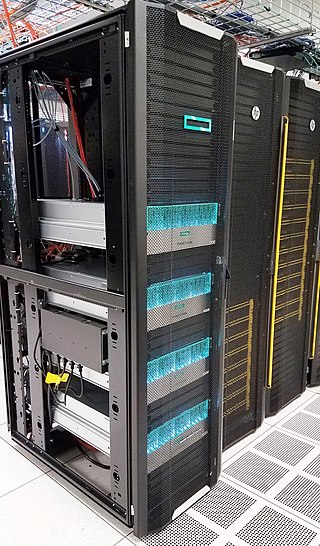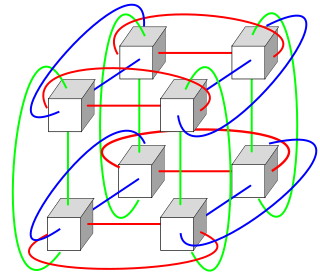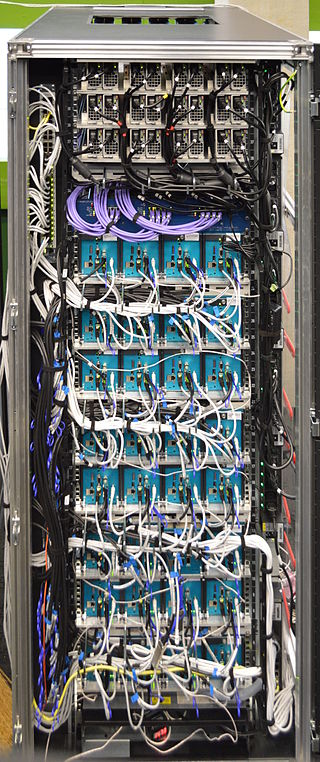
The Scalable Coherent Interface or Scalable Coherent Interconnect (SCI), is a high-speed interconnect standard for shared memory multiprocessing and message passing. The goal was to scale well, provide system-wide memory coherence and a simple interface; i.e. a standard to replace existing buses in multiprocessor systems with one with no inherent scalability and performance limitations.
Tandem Computers, Inc. was the dominant manufacturer of fault-tolerant computer systems for ATM networks, banks, stock exchanges, telephone switching centers, 911 systems, and other similar commercial transaction processing applications requiring maximum uptime and zero data loss. The company was founded by Jimmy Treybig in 1974 in Cupertino, California. It remained independent until 1997, when it became a server division within Compaq. It is now a server division within Hewlett Packard Enterprise, following Hewlett-Packard's acquisition of Compaq and the split of Hewlett-Packard into HP Inc. and Hewlett Packard Enterprise.
Message Passing Interface (MPI) is a standardized and portable message-passing standard designed to function on parallel computing architectures. The MPI standard defines the syntax and semantics of library routines that are useful to a wide range of users writing portable message-passing programs in C, C++, and Fortran. There are several open-source MPI implementations, which fostered the development of a parallel software industry, and encouraged development of portable and scalable large-scale parallel applications.

Quadrics was a supercomputer company formed in 1996 as a joint venture between Alenia Spazio and the technical team from Meiko Scientific. They produced hardware and software for clustering commodity computer systems into massively parallel systems. Their highpoint was in June 2003 when six out of the ten fastest supercomputers in the world were based on Quadrics' interconnect. They officially closed on June 29, 2009.
OpenSSI is an open-source single-system image clustering system. It allows a collection of computers to be treated as one large system, allowing applications running on any one machine access to the resources of all the machines in the cluster.

NonStop is a series of server computers introduced to market in 1976 by Tandem Computers Inc., beginning with the NonStop product line. It was followed by the Tandem Integrity NonStop line of lock-step fault tolerant computers, now defunct. The original NonStop product line is currently offered by Hewlett Packard Enterprise since Hewlett-Packard Company's split in 2015. Because NonStop systems are based on an integrated hardware/software stack, Tandem and later HPE also developed the NonStop OS operating system for them.

The RapidIO architecture is a high-performance packet-switched electrical connection technology. RapidIO supports messaging, read/write and cache coherency semantics. Based on industry-standard electrical specifications such as those for Ethernet, RapidIO can be used as a chip-to-chip, board-to-board, and chassis-to-chassis interconnect.

The R10000, code-named "T5", is a RISC microprocessor implementation of the MIPS IV instruction set architecture (ISA) developed by MIPS Technologies, Inc. (MTI), then a division of Silicon Graphics, Inc. (SGI). The chief designers are Chris Rowen and Kenneth C. Yeager. The R10000 microarchitecture is known as ANDES, an abbreviation for Architecture with Non-sequential Dynamic Execution Scheduling. The R10000 largely replaces the R8000 in the high-end and the R4400 elsewhere. MTI was a fabless semiconductor company; the R10000 was fabricated by NEC and Toshiba. Previous fabricators of MIPS microprocessors such as Integrated Device Technology (IDT) and three others did not fabricate the R10000 as it was more expensive to do so than the R4000 and R4400.

The SGI Origin 2000 is a family of mid-range and high-end server computers developed and manufactured by Silicon Graphics (SGI). They were introduced in 1996 to succeed the SGI Challenge and POWER Challenge. At the time of introduction, these ran the IRIX operating system, originally version 6.4 and later, 6.5. A variant of the Origin 2000 with graphics capability is known as the Onyx2. An entry-level variant based on the same architecture but with a different hardware implementation is known as the Origin 200. The Origin 2000 was succeeded by the Origin 3000 in July 2000, and was discontinued on June 30, 2002.
The Origin 3000 and the Onyx 3000 is a family of mid-range and high-end computers developed and manufactured by SGI. The Origin 3000 is a server, and the Onyx 3000 is a visualization system. Both systems were introduced in July 2000 to succeed the Origin 2000 and the Onyx2 respectively. These systems ran the IRIX 6.5 Advanced Server Environment operating system. Entry-level variants of these systems based on the same architecture but with a different hardware implementation are known as the Origin 300 and Onyx 300. The Origin 3000 was succeeded by the Altix 3000 in 2004 and the last model was discontinued on 29 December 2006, while the Onyx 3000 was succeeded by the Onyx4 and the Itanium-based Prism in 2004 and the last model was discontinued on 25 March 2005.

A computer cluster is a set of computers that work together so that they can be viewed as a single system. Unlike grid computers, computer clusters have each node set to perform the same task, controlled and scheduled by software.
NonStop Clusters (NSC) was an add-on package for SCO UnixWare that allowed creation of fault-tolerant single-system image clusters of machines running UnixWare. NSC was one of the first commercially available highly available clustering solutions for commodity hardware.
The Alpha 21364, code-named "Marvel", also known as EV7 is a microprocessor developed by Digital Equipment Corporation (DEC), later Compaq Computer Corporation, that implemented the Alpha instruction set architecture (ISA).

The Slurm Workload Manager, formerly known as Simple Linux Utility for Resource Management (SLURM), or simply Slurm, is a free and open-source job scheduler for Linux and Unix-like kernels, used by many of the world's supercomputers and computer clusters.

A torus interconnect is a switch-less network topology for connecting processing nodes in a parallel computer system.
Data center is a pool of resources interconnected using a communication network. Data Center Network (DCN) holds a pivotal role in a data center, as it interconnects all of the data center resources together. DCNs need to be scalable and efficient to connect tens or even hundreds of thousands of servers to handle the growing demands of Cloud computing. Today's data centers are constrained by the interconnection network.

QPACE 2 is a massively parallel and scalable supercomputer. It was designed for applications in lattice quantum chromodynamics but is also suitable for a wider range of applications..
Torus fusion (tofu) is a proprietary computer network topology for supercomputers developed by Fujitsu. It is a variant of the torus interconnect. The system has been used in the K computer and the Fugaku supercomputer.
Timothy M. Pinkston is an American computer engineer, researcher, educator and administrator whose work is focused in the area of computer architecture. He holds the George Pfleger Chair in Electrical and Computer Engineering and is a Professor of Electrical and Computer Engineering at University of Southern California (USC). He also serves in an administrative role as Vice Dean for Faculty Affairs at the USC Viterbi School of Engineering.
Arun K. Somani is Associate Dean for Research of College of Engineering, Distinguished Professor of Electrical and Computer Engineering and Philip and Virginia Sproul Professor at Iowa State University. Somani is Elected Fellow of Institute of Electrical and Electronics Engineers (IEEE) for “contributions to theory and applications of computer networks” from 1999 to 2017 and Life Fellow of IEEE since 2018. He is Distinguished Engineer of Association for Computing Machinery(ACM) and Elected Fellow of The American Association for the Advancement of Science(AAAS).








